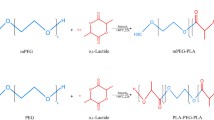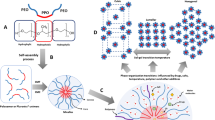Abstract
Purpose
Despite the fact that r-hGH was first approved for use by FDA in 1995 and the conventional dosage form in the market has a limitation of daily subcutaneous injections, there remains a lack of sustained delivery system in the market. Nutropin depot, a long-acting dosage form of r-hGH was approved for marketing by FDA in 1999, however, it was discontinued in 2004. Since then, unabating efforts have been made to develop biodegradable polymer based formulations for r-hGH delivery. However, grey area is the comprehension of structural stability of r-hGH at an interface with the polymer and it is of utmost important to attain safe and efficacious sustained delivery system. The purpose of this study was to evaluate the changes in structure of r-hGH upon adsorption at biodegradable PLGA nanoparticles of different hydrophobicity as a function of pH.
Methods
DLS, fluorescence spectroscopy, and CD were collectively employed to evaluate structural changes in r-hGH.
Results
The studies revealed that r-hGH is most stable with low to high hydrophobicity PLGA grades under pH 7.2 followed by 5.3.
Conclusion
Overall, the nature and magnitude of structural changes observed has a strong dependence on the pH and differences and degree of hydrophobicity of PLGA.

















Similar content being viewed by others
Abbreviations
- % w/v :
-
Percentage weight by volume
- BSA:
-
Bovine serum albumin
- CD:
-
Circular dichroism
- Dh:
-
Hydrodynamic diameter
- DLS:
-
Dynamic light scattering
- g/cm3 :
-
Gram per cubic centimeter
- kDa:
-
Kilodalton
- MES:
-
2-(N-morpholine)-ethane sulphonic acid
- mg:
-
Milligram
- min:
-
Minute
- ml:
-
Milliliter
- MW:
-
Molecular weight
- MWCO:
-
Molecular weight cut off
- nm:
-
Nanometer
- PDI:
-
Polydispersity index
- pI:
-
Isoelectric point
- PLGA 5050 1A:
-
Poly (lactic-co-glycolic) acid uncapped polymer, ~ 10 kDa
- PLGA 5050 5E:
-
Poly (lactic-co-glycolic) acid ester endcapped polymer, ~ 50 kDa
- PLGA 8515 3 CE:
-
Poly (lactic-co-glycolic) acid ester endcapped polymer, ~30 kDa
- PS:
-
Polystyrene
- r-hGH:
-
Recombinant human growth hormone
- SD:
-
Standard Deviation
- Trp:
-
Tryptophan
- Tyr:
-
Tyrosine
- UV:
-
Ultraviolet
- V:
-
Volume
- г:
-
Surface Coverage
- гPL:
-
Plateau Surface Coverage
References
Cutfield WS, Derraik JGB, Gunn AJ, Reid K, Delany T, Robinson E, et al. Non-compliance with growth hormone treatment in children is common and impairs linear growth. PLoS One. 2011;6(1):e16223.
Jahan ST, Haddadi A. Investigation and optimization of formulation parameters on preparation of targeted anti-CD205 tailored PLGA nanoparticles. Int J Nanomedicine. 2015;10(1):7371–84.
Castellanos IJ, Cruz G, Crespo R, Greibenow K. Encapsulation-induced aggregation and loss in activity of y-chymotrypsin and their prevention. J Control Release. 2002;81:307–19.
Schellekens H. How to predict and prevent the immunogenicity of therapeutic proteins? Biotechnol Annu Rev. 2008;14:191–202.
Buijs J, David WB, Hlady V. Human growth hormone adsorption kinetics and conformation on self-assembled monolayers. Langmuir. 1998;14(2):335–41.
Motheram R, Gupta PK. Behavior of Recombinant Human Growth Hormone at Solid/Liquid Interfaces. University of the Sciences in Philadelphia, ProQuest Dissertations Publishing. 2007;3264503. (These are internal data from the doctoral dissertation of a student in Usciences, not peer reviewed).
Kwak HH, Shim WS, Choi MK, Son MK, Kim YJ, Yang HC, et al. Development of a sustained-release recombinant human growth hormone formulation. J Control Release. 2009;137(2):160–5.
Cai Y, Xu M, Yuan M, Liu Z, Yuan W. Developments in human growth hormone preparations: sustained-release, prolonged half-life, novel injection devices, and alternative delivery routes. Int J Nanomedicine. 2014;9(1):3527–38.
Herbert P, Murphy K, Johnson O, Dong N, Jaworowicz W, Tracy MA, et al. A large-scale process to produce microencapsulated proteins. Pharm Res. 1998;15(2):357–61.
Lakowicz JR. Protein fluorescence. In: Lakowicz JR, editor. Principles of fluorescence spectroscopy. 2nd ed. New York: Kluwer Academic/Plenum; 1999. p. 445–86.
Clark SR, Billsten P, Mandenius C-F, Elwing H. Fluorimetric investigation of recombinant human growth hormone adsorbed on silica nanoparticles. Anal Chim Acta. 1994;290:21–6.
Bewley TA, Brovetto-Cruz J, Li CH. Human pituitary growth hormone. XXI. Physicochemical investigations of the native and reduced-alkylated protein. Biochemistry. 1969;8:4701–8.
Nutropin depot [Somatropin (rDNA origin) for injectable suspension], [package insert]. San Fransisco: Genentech, Inc. 2004. 21075_S008_annotated_OCT 2004.
Desai P, Gupta PK. Adsorption behavior of recombinant human growth hormone at moderately hydrophobic surfaces. University of the Sciences in Philadelphia, ProQuest Dissertations Publishing. 2010;3411393. (These are internal data from the doctoral dissertation of a student in Usciences, not peer reviewed).
Holzwarth G, Doty P. The ultraviolet circular dichroism of polypeptides. J Amer Chem Soc. 1965;87:218–28.
Greenfield N, Fasman GD. Computed circular dichroism spectra for the evaluation of protein conformation. Biochemistry. 1969;8:4108–16.
Chapman D, Wallach DFH. In: Biological Membranes. Edited by Chapman D. London and N.Y: Academic Press. 1968. pp.125–202.
Bewley TA, Li CH. Human pituitary growth hormone: XXII. The reduction and reoxidation of the hormone. Arch Biochem Biophys. 1970;138:338–46.
Horwitz J, Strickland EH, Billups CB. Analysis of the vibrational structure in the near-ultraviolet circular dichroism and absorption spectra of tyrosine derivatives and ribonuclease-a at 77 deg. K. J Amer Chem Soc. 1970;92:2119–29.
Gomez-Orellana I, Variano B, Miura-Fraboni J, Milstein S, Paton DR. Thermodynamic characterization of an intermediate state of human growth hormone. Protein Sci. 1998;1:1352–8.
Sirsi SR, Schray RC, Wheatley MA, Lutz GJ. Formulation of polylactide-co-glycolic acid nanospheres for encapsulation and sustained influence of polymer behaviour in organic solution on the production of polylactide nanoparticles by nanoprecipitation. Release of poly(ethylene imine)-poly(ethylene glycol) copolymers complexed to oligonucleotides. J Nanobiotechnol. 2009;7:1.
Aloj S, Edelhoch H. The molecular properties of human growth hormone. J Biol Chem. 1972;247(4):1146–52.
Bremer MGEG, Duval J, Norde W, Lyklema J. Electrostatic interactions between immunoglobin (IgG) molecules and a charged sorbent. Colloids Surf A Physicochem Eng Asp. 2004;250:29–42.
Demanèche S, Chapel JP, Monrozier LJ, Quiquampoix H. Dissimilar pH-dependent adsorption features of bovine serum albumin and alpha-chymotrypsin on mica probed by AFM. Colloids Surf B. 2009;70:226–31.
Höök F, Rodahl M, Kasemo B, Brzezinski P. Proc. Structural changes in hemoglobin during adsorption to solid surfaces: effects of pH, ionic strength, and ligand binding. Natl Acad Sci USA. 1998;95:12271–6.
Rabe M, Verdes D, Seeger S. Understanding protein adsorption phenomena at solid surfaces. Adv Colloid Interf Sci. 2011 Feb 17;162(1–2):87–106.
Pace CN, Shirley BA, McNutt M, Gajiwala K. Forces contributing to the conformational stability of proteins. FASEB J. 1996;10(1):75–83. -11
Chantalat L, Jones ND, Korber F, Navaza J, Pavlosky AG. The crystal structure of wild-type growth-hormone at 2.5 angstrom resolution. Protein Pept Lett. 1995;2:333.
Eftink MR. Fluorescence techniques for studying protein structure. Methods Biochem Anal. 1990;35:117–29.
Steiner R, Kirby E. The interaction of the ground and excited states of indole derivatives with electron scavengers. J Phys Chem. 1969;73:4130–5.
Chen Y, Liu B, Yu HT, Barkley M. The peptide bond quenches indole fluorescence. J Am Chem Soc. 1996;118:9271–8. https://doi.org/10.1021/ja961307u. [Cross Ref]
Adams P, Chen Y, Ma K, Zagorski M, Sönnichsen F, McLaughlin M, et al. Intramolecular quenching of tryptophan fluorescence by the peptide bond in cyclic hexapeptides. J Am Chem Soc. 2002;124:9278–86. https://doi.org/10.1021/ja0167710.
Ghisaidoobe ABT, Chung SJ. Intrinsic tryptophan fluorescence in the detection and analysis of proteins: a focus on Förster resonance energy transfer techniques. Schneckenburger H, ed. Int J Mol Sci. 2014;15(12):22518–38. https://doi.org/10.3390/ijms151222518.
Chen Y, Barkley MD. Toward understanding tryptophan fluorescence in proteins. Biochemistry. 1998;
Vander Donckt E. Fluorescence solvent shifts and singlet excited state pk's. of indole derivatives. Bull Soc Chim Belg. 1969;78:69–75.
Yu H-T, Colucci WJ, McLaughlin ML, Barkley MD. Fluorescence quenching in indoles by excited-state proton transfer. J Am Chem Soc. 1992;114:8449–54.
Chen Y, Liu B, Barkley MD. Trifluoroethanol quenches indole fluorescence by excited-state proton transfer. J Am Chem Soc. 1995;117:5608–9.
Saito I, Sugiyama H, Yamamoto A, Muramatsu S, Matsuura T. Photochemical hydrogen-deuterium exchange reaction of tryptophan. The role in nonradioative decay of singlet tryptophan. J Am Chem Soc. 1984;106:4286–7.
Shizuka H, Serizawa M, Kobayashi H, Kameta K, Sugiyama H, Matsuura T, et al. Excited-state behavior of tryptamine and related indoles. Remarkably efficient intramolecular proton-induced quenching. J Am Chem Soc. 1988;110:1726–32.
Buijs J, Hlady VV. Adsorption kinetics, conformation, and mobility of the growth hormone and lysozyme on solid surfaces, studied with TIRF. J Colloid Interface Sci. 1997;190:171–81.
Vlasova IM, Zhuravleva VV, Saletsky AM. Denaturation of bovine serum albumin initiated by sodium dodecyl sulfate as monitored via the intrinsic fluorescence of the protein. Russ J Phys Chem B. 2014;8:385–90. https://doi.org/10.1134/S1990793114030154.
Guanghui Ma, Zhi-Guo Su, Wang L, Yang T. Microspheres and microcapsules in biotechnology: design, preparation and application. Drug Loading methods. Boca Raton: CRC Press; 2013. pp. 271. International standard book number -13: 978-981-4364-62-1(ebook-PDF).
Author information
Authors and Affiliations
Corresponding author
Rights and permissions
About this article
Cite this article
Shah, V.R., Gupta, P.K. Structural Stability of Recombinant Human Growth Hormone (r-hGH) as a Function of Polymer Surface Properties. Pharm Res 35, 98 (2018). https://doi.org/10.1007/s11095-018-2372-y
Received:
Accepted:
Published:
DOI: https://doi.org/10.1007/s11095-018-2372-y




